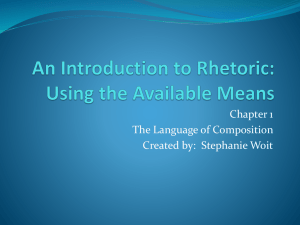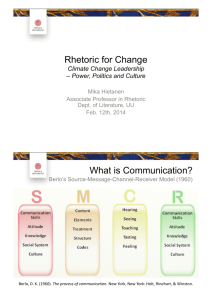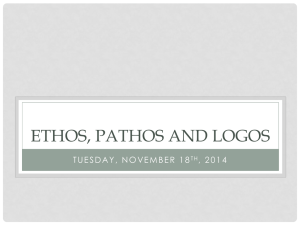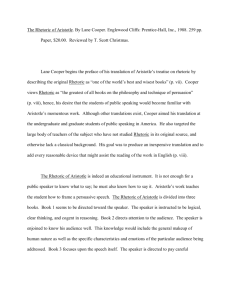Essential Skills in Dynamic Public Speaking - AIM-IRS
advertisement
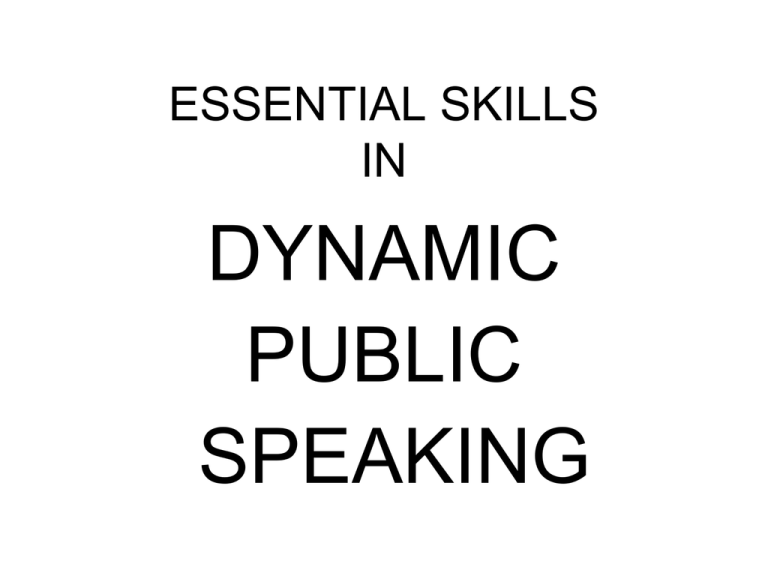
ESSENTIAL SKILLS IN DYNAMIC PUBLIC SPEAKING The Blessing God, that all-powerful Creator of nature and architect of the world, has impressed man with no character so proper to distinguish him from other animals, as by the faculty of speech. ~ Quintilian Who, What, Why, Where, When & How The Road Map WHO WHO? • Who ARE YOU? • Who is your audience? • Who is your “target” audience? WHO you are! • Every prospective speaker should ask, "Is there a particular cause that has personal significance for me? If I could change something about the world, what would I choose? If studying the art of public speaking will give me the tools to influence the world around me, how will I use them?" Who ARE you? • Before you can convince an audience to accept anything you say, they have to accept you as credible. • There are many aspects to building your credibility: – Does the audience respect you? – Does the audience believe you are of good character? – Do they believe you are genuinely trustworthy? – Do they believe that you are an authority on your subject matter? WHO are YOU? • Do you feel more comfortable giving a speech in front of a large crowd, or having a low-key conversation with your friends? • If you chose the second option, you’re in good company. After all, we practice our conversational skills every day. Who is your AUDIENCE? If you would like to change the world, remember--public speaking is an effective platform for spreading revolutionary ideas. So then….. The WORLD is your AUDIENCE Who is your TARGET Audience? • Co-Workers/Peers vs. Supervisor/Mgrs vs. Executives • Friends vs. Church Members vs. Clergy • KKK > Civil Rights Organization Puzzling 101 The “WHAT” piece of the Public Speaking Puzzle WHAT Words to the Wise “There are three things to aim at in Public Speaking: First, to get into your subject, Then to get your subject into yourself, and Lastly, to get your subject into the heart of your audience.” ~ Alexander Gregg “There is only one excuse for a speaker's asking the attention of his audience: he must have either truth or entertainment for them.” ~ Dale Carnegie What IS Public Speaking? While our current knowledge and practice of public speaking draws upon the Western thought from Greece and Rome, Public speaking is a process of speaking to a group of people in a structured, deliberate manner intended to inform, influence, or entertain the listeners - Orator A skilled and eloquent public speaker - Rhetoric The art of using language, especially public speaking, as a means to persuade. Public Speaking vs Conversation A conversation is a casual dialogue in which two or more parties exchange ideas back and forth. A speech is a monologue in which the speaker presents his or her perspective with no interruptions from the audience. In a conversation, each person mentions questions, concerns, and objections as they come up. In the context of a speech, audience members cannot address their concerns in real time. The Purpose of WHAT Aristotle defined rhetoric as the “faculty of discovering the possible means of persuasion in reference to any subject whatever.” Aristotle divided the “means of persuasion” into three parts, or three artistic proofs, necessary to persuade others. The “WHY” piece of the Public Speaking Puzzle WHY Words to the Wise “SPEECH IS POWER: SPEECH IS TO PERSUADE, TO CONVERT, TO COMPEL.” ~ Ralph Waldo Emerson “If you don’t know what you want to achieve in your presentation your audience never will.” ~ Harvey Diamond WHY? • Public speaking can be a great self-esteem booster. • Public speaking engagements are great places to meet new social and professional contacts • There is a strong correlation between communication skills and leadership. Effective speakers can use knowledge of persuasion to motivate others to take collective action to achieve desired goals. *Examples (Good/Bad) The Purpose of Why • Do your words evoke feelings of … love? … sympathy? … fear? • Do your visuals evoke feelings of compassion? … envy? • Are you merely speaking in public or utilizing the tools, effectively, of public speaking? The “WHERE” piece of the Public Speaking Puzzle WHERE Words to the Wise “The customer is always right' may have become a standard motto in the world of business, but the idea that 'the audience is always right,' has yet to make much of an impression on the world of presentation, even though for the duration of the presentation at least, the audience is the speaker's only customer.” Max Atkinson The Road Less Traveled or perhaps….. The Road MORE Traveled • The formal study of public speaking began approximately 2,500 years ago in Greece and Rome to train citizens to participate in society, but more so it was the one true method of sure communication. Periods of Schools of Thought • The Classical Period (500 BCE-400 BCE) – Aspasia of Miletus, Socrates, Plato, and Aristotle. – Cicero and Quintilian • The Medieval Period (400 CE-1400 CE) – St. Augustine • The Renaissance (1400-1600 CE) – Petrus Ramus and Francis Bacon • The Enlightenment (1600-1800 CE) – George Campbell • New School--1900s and 2000s Through Today Rhetoric 101 rhet·o·ric Spelled [ret-er-ik] noun 1. (in writing or speech) the undue use of exaggeration or display; bombast. 2. the art or science of all specialized literary uses of language in prose or verse, including the figures of speech. 3. the study of the effective use of language. 4. the ability to use language effectively. 5. the art of prose in general as opposed to verse. The “Father” of Rhetoric Aristotle is thought to be the father of many of the schools of thought that operate today. * The Buckley School * Dale Carnegie * Toastmasters Many teachers of communication, speech, and rhetoric consider Aristotle’s On Rhetoric to be a seminal work in the field and a major periodical work called it “the most important single work on persuasion ever written.” Written in the 4th century B.C.E., the Greek philosopher Aristotle compiled his thoughts on the art of rhetoric into On Rhetoric, including his theory on the three persuasive appeals. Aristotle defined rhetoric as the “faculty of discovering the possible means of persuasion in reference to any subject whatever.” 2300 years ago, Aristotle wrote down the secret to being a persuasive speaker, the secret which forms the basis for nearly every public speaking book written since then. The Secret Three Pillars of Public Speaking ETHOS PATHOS LOGOS The Secret Revealed • Ethos - Speaker Credibility • Pathos - Emotional Connection • Logos - Logical Argument The Purpose of WHERE • In order to have a “Finished Line” you must have a “Starting Line”. “Professor Johnston often said that if you didn't know history, you didn't know anything. You were a leaf that didn't know it was part of a tree.” ~Michael Crichton The “WHEN” to the Public Speaking Puzzle WHEN Words to the Wise “The problem with speeches isn’t so much not knowing when to stop, as knowing when not to begin.” ~ Frances Rodman “Public speaking is the art of diluting a two-minute idea with a two-hour vocabulary.” ~ Evan Esar “To listen closely and reply well is the highest perfection we are able to attain in the art of conversation.” ~ Francois de La Rochefoucauld WHEN is the right time? The RIGHT TIME Is WHEN The Purpose of WHEN • Today, the reach of technology is pervasive and global. In the past, influencing others involved speaking directly to an audience face-to-face or having expensive equipment for broadcasting. Today, modern communication technology coupled with the internet means that speakers can share messages and thoughts with audiences anyplace in the world for the cost of an internet connection and a camera, or simply a smart phone recorder. Ethos, Pathos, Logos In the simplest terms, Aristotle’s “Secret” corresponds to: • WHO = Ethos: credibility (or character) of the speaker • WHAT/WHEN = Pathos: emotional connection to the audience • WHY = Logos: logical argument Together, they are the three persuasive appeals. In other words, these are the three essential qualities that your speech or presentation must have before your audience will accept your message. The Finished Puzzle HOW Words to the Wise “The success of your presentation will be judged NOT by the knowledge you send BUT by what the listener receives.” ~ LILLY WALTERS “Be still when you have nothing to say; when genuine passion moves you, say what you’ve got to say, and say it hot.” ~ D. H. Lawrence Learning to Speak • The flip side of public speaking is listening; people can learn how to influence by learning how to listen. Trained speakers know how to recognize sound logic, reasoning, and ethical appeals. • A critical listener is less likely to be persuaded by unsound logic and fallacies or to take action that is not in his or her best interest. Listening and Hearing • If etiquette dictates that you should listen to your conversation partner, shouldn't you also to try to listen to the audience at a public speaking engagement? • Try to anticipate these questions, concerns, and objections, and incorporate responses into your speech. • If you imagine your speech as a conversation in which you take both parts, it may be easier to give the audience's concerns prompt and thorough consideration. Common Cents? • Remember to "dress to impress"--when in doubt, go for business professional. It's better to be overdressed for a speech or presentation than underdressed. • Your verbal communication, in how you phrase and intone your actual words, is vital to building auditory interest for your audience. Try to play with the pitch and tone of your speech; avoid speaking in monotone. Common Sense • Your audience “senses” you just as much as they hear you. • From gesture to posture, your non-verbal communication via your body language also adds visual depth and engagement for your audience. Maintain eye contact. Don't wander around stage or gesticulate too much. Make your audience feel comfortable by being comfortable in front of them. The Classic Pause • Practice and Timing • Focus on delivery as a whole instead of nitpicking every sound that comes out of your mouth • If you forget, remember that your audience really never knows what you’re going to say, so….. Rhetorically Speaking “The best way to sound like you know what you're talking about is to know what you're talking about.” ~Author Unknown 25 Necessary Skills • • • Research a topic – Good speakers stick to what they know. Great speakers research what they need to convey their message. Focus – Help your audience grasp your message by focusing on your message. Stories, humour, or other “sidebars” should connect to the core idea. Anything that doesn’t needs to be edited out. Organize ideas logically – A well-organized presentation can be absorbed with minimal mental strain. Bridging is key. • • • • Tell a story – Everyone loves a story. Points wrapped up in a story are more memorable, too! Start Strong and close stronger– The body of your presentation should be strong too, but your audience will remember your first and last words (if, indeed, they remember anything at all). Interact with the audience – Ask questions (and care about the answers). Solicit volunteers. Make your presentation a dialogue. Incorporate humor – Knowing when to use humor is essential. So is developing the comedic timing to deliver it with greatest effect. • • • • Utilize 3-dimensional space – Chaining yourself to the lectern limits the energy and passion you can exhibit. Lose the notes, and lose the chain. Complement words with visual aids – Visual aids should aid the message; they should not be the message. Analyze your audience – Deliver the message they want (or need) to hear. Connect with the audience – Eye contact is only the first step. • Vary vocal pace, tone and volume – A monotone voice is like fingernails on the chalkboard. • Master metaphors – Metaphors enhance the understandability of the message in a way that direct language often can not. • Punctuate words with gestures – Gestures should complement your words in harmony. Tell them how big the fish was, and show them with your arms. • Employ quotations, facts, and statistics – Don’t include these for the sake of including them, but do use them appropriately to complement your ideas. • • • • Conduct a “Q & A” Session – Not every speaking opportunity affords a Q&A session, but understand how to lead one productively. Use the Q&A to solidify the impression that you are an expert, not (just) a speaker. Lead a discussion – Again, not every speaking opportunity affords time for a discussion, but know how to engage the audience productively. Obey time constraints – Maybe you have 2 minutes. Maybe you have 45. Either way, customize your presentation to fit the time allowed, and respect your audience by not going over time. Craft an introduction – Set the context and make sure the audience is ready to go, whether the introduction is for you or for someone else. • • • Handle unexpected issues smoothly – Maybe the lights will go out. Maybe the projector is dead. Have a plan to handle every situation. Be coherent when speaking off the cuff – Impromptu speaking (before, after, or during a presentation) leaves a lasting impression too. Doing it well tells the audience that you are personable, and that you are an expert who knows their stuff beyond the slides and prepared speech. Seek and utilize feedback – Understand that no presentation or presenter (yes, even you!) is perfect. Aim for continuous improvement, and understand that the best way to improve is to solicit candid feedback from as many people as you can. • Exhibit confidence and poise – These qualities are sometimes difficult for a speaker to attain, but easy for an audience to sense. • Listen critically and analyze other speakers – Study the strengths and weakness of other speakers. • Act and speak ethically – Since public speaking fears are so common, realize the tremendous power of influence that you hold. Use this power responsibly Developing YOU • The Naked Presenter by Garr Reynolds • Back of the Napkin: Solving Problems and Selling Ideas with Pictures by Dan Roam – (Smart people who want to improve their visual thinking skills) • Slide:ology: The Art and Science of Creating Great Presentations by Nancy Duarte – (Any and everyone who wants a classic reference test for presentation design. A definite read and re-read) • Speak Like Churchill, Stand Like Lincoln: 21 Powerful Secrets of History’s Greatest Speakers – (Speakers who seek to elevate their speechwriting and delivery from good to GREAT)
